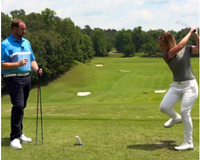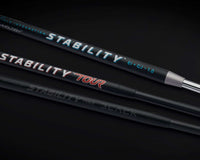Are you a serious golfer trying to improve your game? Tired of not knowing if what you are
doing is actually building towards better performance?

Putting requires 3 things to be in-tune for you to start seeing that ball disappear in the cup:
-
The right Read
-
The right Plan
-
Executing the plan
This is a lot like life. You might have a great car but if you don’t have a map and then a route on that map, you are never going to reach without lots of inefficiencies or hardship. Putting is the same. In this article we are going to talk about how your technique or our equipment can affect your read, plan, execute strategy.
Let’s assume you’ve read a putt as a “inside right” putt. Now you have to decide how far to aim to the right for the ball start on a line that realizes that read.
When we do an assessment we always start with aim. We all have tendencies on aiming and just need to understand how our vision and perception can affect that aim. What I perceive as a right edge putt (assume similar speed), might be inside for you.

In the video below you can see that I’m using some real-time data to see what face, shaft lean, and lie angle are all doing relative to my start line at address. For the vast majority of golfers getting your putter face square to your intended target line is a necessity if you want to make the putt. We are using a great tool by @captoputting. So by playing with the setup I can instantly know if I’m actually setting up my putter for success.
Now what could go wrong:
1. Lie Angle (Directional Control): There is not generic lie angle that is “correct” for

you. It needs to be checked for you. When your lie angle is off, you will struggle with directional control. So what does this mean? Where you or your coach want your hands or body makes the putter sit too upright or flat (toe up or heel up). So either your putter lie angle needs to be adjusted or technique needs to be adjusted.
2. Loft angle (Distance Control): There is a generic loft angle that is “correct” for
you and that is around 3.5° and works for average green speeds (~9-10’). But it must be checked/determined by your address position and what you do with your hards through the stroke. A standard loft at 3.5° can be good for a variety of green/surfaces, however, as you can see based on changing shaft lean/forward press at the address and at impact you might not be delivering the right loft at impact. So what are the options? As you can see forward press can be added or reduced with the setup. But if where you or your coach want you to be is starting and you deliver a loft less than 3.5°, it should be adjusted.
3. Face Angle (Directional Control): Most putters don’t have an issue with the face out of alignment. But what does change is the grip alignment. We get out of alignment grips in our shop all the time. And except for the odd bent putter face, face tends to be more technique drive. So, practicing with a square line to your target really helps your focus and acceptance of what is square. In the video and image above, you can see that we use the @visioputting MiTemplate to help with face angle.
In fact at that recent putting events we conducted 1/3 of
the participants had grip alignment issues. That means that just
holding their grip forced the face open or closed. In those same
events we had about the same proportion of players with lofts
less than 2.5°!
TO LEARN MORE ASK BELOW OR BOOK YOUR PUTTING ASSESSMENT TODAY



